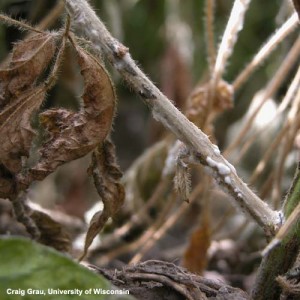Reducing the risk of white mold and maximizing soybean yield in the presence of white mold can be achieved on a field-by-field basis by choosing management practices that:
- prevent or slow the introduction of the white mold pathogen into a field
- steadily work towards reducing the population of the fungus in the soil
- provide a feasible compromise between lower white mold potential and maximum yield potential
Variety selection is the foundation of white mold control. Varieties range from moderately resistant to very susceptible within maturity groups 0 through II. No soybean cultivar is yet completely resistant to S. sclerotiorum, but several cultivars have been observed in Wisconsin trials to be less diseased and to yield consistently higher than other cultivars in the presence of white mold. This is an area of active research.
Canopy management affects the activity of the white mold fungus each season. Early planting date, narrow row width, and high plant populations (>200,000 plants/a) all accelerate canopy closure and favor activity of the white mold fungus. Bushy soybean varieties and lodging also create a dense, closed canopy which favors white mold growth.
Crop rotation can reduce the number of sclerotia in soil. At least two or three years of a nonhost crop such as corn, small grains and forage legumes is required. Weed control is also important, as many broadleaf weeds are hosts of the white mold pathogen. Common host crops which should not be in soybean rotation in fields with white mold risk are beans, peas, sunflowers and cole crops.
Tillage system: Moldboard plowing buries sclerotia, but also brings them back up to the soil surface when the field is plowed again. More sclerotia are found near the soil surface in no-till systems. Early research results suggest that sclerotia numbers begin to decline if left undisturbed near the soil surface. However, viability is maintained if they are buried 8-10 inches in the soil.
Weed control is an important aspect of control. Many broadleaf weeds are hosts of the white mold pathogen. There is also some evidence that the herbicides Colbra® and Pursuit® suppress the activity of the fungus. The herbicide Atrizine® appears to be toxic to the fungus by disrupting germination of sclerotia.



